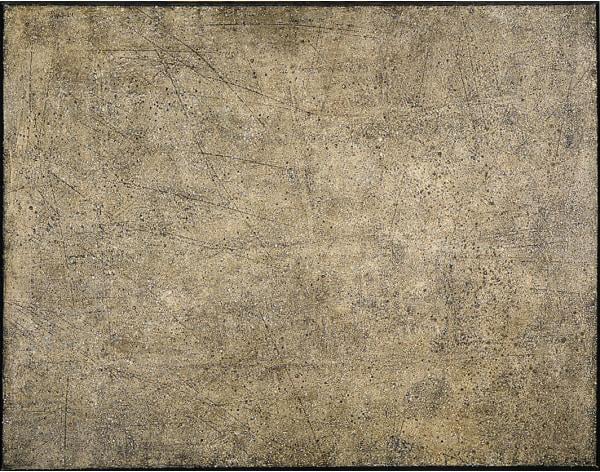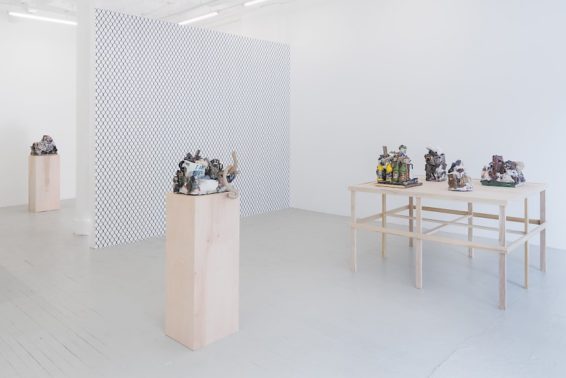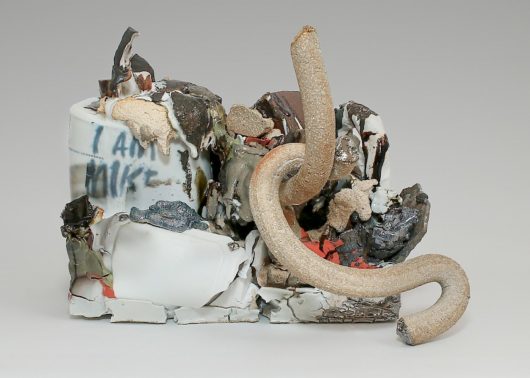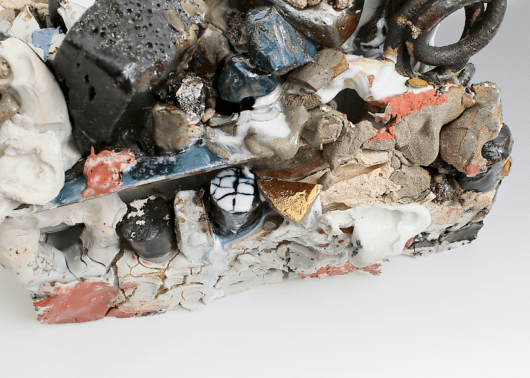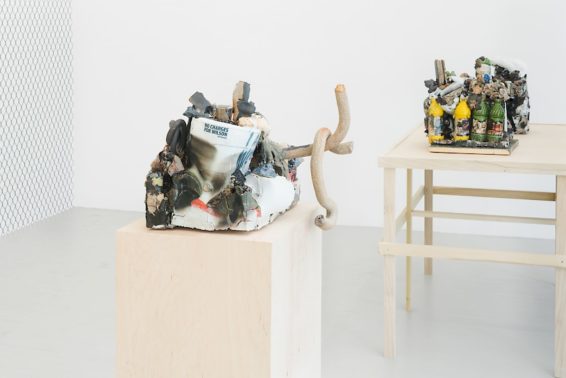On my first rushed visit to the Saint Louis Art Museum—a museum far bigger than I anticipated—I stopped in front Jean Dubuffet’s Texturologie XXXI, from April 1958. It’s only later that you can start to sort out why a particular work exerts its pull. I had little time. Running late, I only wanted to get a sense of the collection, and was mostly fast-walking and glancing. But something about this painting stopped me.
I looked for a while. At first glance, the painting seems like pure abstraction. Or, like a pock-marked and dirtied but otherwise blank sheet of medieval parchment, too large and perfectly rectangular to be made from any sheep, goat, or cow. But the surface was dry like stone, not oily like animal skin.
I’d never seen Dubuffet like this, so seemingly blank. The wall text indicated he’d used a drip method (about a decade after Jackson Pollock’s first drip paintings) and incorporated sand, gravel, and plaster, which he then scored away at. The effect was subtle and rich—starkly different than any Pollock I’d seen, and drastically more subdued than my favorite Joan Mitchell paintings. I wanted to think about this work in relation to hers—maybe because they had a giant Mitchell canvas from the very end of her career a few galleries over. When I left, I realized that the only two images I took with me from the museum, captured on my phone, were a shot of the Dubuffet painting and another of its label. On the label, I now see, the artist is quoted: “I meant to evoke any area of bare ground—preferably esplanade or roadway—seen from above.”
***
A day or two after returning to New York from St. Louis, I was walking down Delancey toward the New Museum when I passed Callicoon Fine Arts. Noticing its exhibition of mostly small tabletop sculpture, I detoured and headed in. I don’t think I even looked to see the name of the artist—Kahlil Robert Irving—though he was completely unknown to me. There was something immediately compelling about the work. I can’t remember seeing a show of objects in this format, a format that I have seen only a handful of artists tackle brilliantly—the wonderful grouping of tabletop Louise Bourgeois sculptures at DIA Beacon, Anthony Caro, Giacometti, and Isa Genzken come to mind. This work had the heft of Bourgeois and the chaos of Genzken (though, in this format, I was thinking of Genzken’s cast-concrete radio-shaped sculptures, which are some of her most austere—like downsized brutalist architecture).
I’m always wanting something when I see art, but I don’t know exactly what. Sometimes, especially lately, in our current cultural moment, I wonder what the point is. Why all this incessant looking? But I can’t seem to stop. I don’t know what it is that I want, yet I want it deeply.
Inside the gallery, I was adrift. Do I even like these? The tabletop sculptures weren’t beautiful. Maybe they were ugly, even, I thought. One wall was papered with a repeating pattern like black chain linked fencing on a white background (of the artist’s design), which helped to break up what might otherwise seem a monotonous gathering of similarly constructed works on a similar scale, all presented on unfussy plywood tables and plinths of the same height. There was also a print with collaged elements, and a hanging bit of stoneware that looked like a cross between rebar and oversized spaghetti, which hung almost haphazardly from a hook on the back of the wallpapered wall—a playfully weird detail.
Irving’s sculptures are not representations of objects, but neither are they unknowable abstractions. They cohere, as if from some intense gravitational pull at their center that is not merely physical or material. Some were like core samples of sedimentary layers from an archeological dig conducted in layers of asphalt. Other works seem like the products of great heat or pressure—or both. Elements of pop and appropriation painting are snuck in, rendered in porcelain or stoneware. There was nothing craft about them. They don’t approximate functional vessels, and things that looked like found objects, which had been incorporated into the dense compositions, were in fact deftly rendered facsimiles: A partially crushed Styrofoam takeout container was actually porcelain. A row of plastic Sprite bottles appeared to be ceramic. They weren’t clear, but were glazed (some yellow, some green) with familiar labels made strange, the Sprite label spliced together with elements of newspaper headlines and pull-quotes.
The texts all refer to or reproduce headlines or graffiti about the killing of Mike Brown in Ferguson (just north of St. Louis) by police officer Darren Wilson. Phrases like “No Charges for Wilson (in Ferguson)” and “I am Mike” are incorporated in such a way and at such a scale that they do not immediately overpower the objects, requiring a careful look to uncover. At times, the text is fragmented or partially obscured. These literal elements are incorporated in some more heterogeneous comingled mass, composed variously of fine china (sometimes of white and blue), fragments of thrift shop coffee cups (sometimes a floral pattern can be made out), and what looks like concrete, gravel, or other architectural rubble. In “Compressed Mass (hidden decoration),” I mistook a gilt semicircle of porcelain or stoneware for gold false teeth.
I recalled the relentless images that followed Brown’s death. The sculptures evoked the most tender of these: the street memorials of flowers, candles, signs, and stuffed animals. Memorials I remember only because I read about how they were destroyed or decimated—a police car driving over the site soon after Mike Brown’s mother spelled out his initials with rose petals, a police dog urinating on the site as protesters and mourners gathered nearby, a sidewalk memorial set on fire. The memorials were largely ephemeral and spontaneous, though a bronze plaque now marks the spot. Irving’s sculptures embody and solidify the tenderness of these memorials and also the memory of their obliteration—it is as if the pavement itself has been lifted up and enfolded, congealing an element of both the memorial and the trauma (personal, local, national, historical) into something gnarled and mineralogical.*
Irving’s sculptures were beautiful. Yet their aesthetic value isn’t the point. The transformation of everyday elements into porcelain and stoneware take them almost out of time, cast the contemporary oddly from some remove, which imbues the contemporary with the heft of history. Was this work a bulwark against erasure—against the erasure of black life and the protestors who put their own bodies on the line, both of whom are being reduced, with time, distance and mediation, to the anesthetized, seemingly immaterial realm of hashtag politics? Irving’s sculptures reaffirm the work of art as a function of social memory while not reducing the work to that single function. His sculptures are agglomerations of mourning and feeling and the street as (desecrated, contested) place.
***
Before I left the gallery, I thought back to the Dubuffet painting in St. Louis. What an odd coincidence, stumbling almost immediately upon my return to New York over this show of sculptures by the St. Louis-based Irving. Dubuffet’s painting—viewed in the antiseptic white-walled hull of the museum, a museum placed deep into an expansive park (with more than one golf course) so that the museum is both in the city and removed from it—was particularly haunting within the context of St. Louis. Irving’s sculptures forced me to confront this realization, though I still don’t completely understand it. This “area of bare ground—preferably esplanade or roadway—seen from above” seemed now both utopian and cruel. Lesley McSpadden, Mike Brown’s mother, dropping rose petals where her son was killed, the road still marked by his blood. The two images fused. What history can a bit of ground, of asphalt, be made to bear?
***
Note: The phrase “gnarled and mineralogical” seemed the perfect description of Irving’s sculptures, but the phrase is not my own. It is adapted from Cathy Park Hong’s essay “Against Witness: Paul Celan, Doris Salcedo, and memory in the Internet age,” which contains a description of the late style of the poetry of Paul Celan (the actual quote in her essay is, “his syntax more gnarled, his images more gnomic and mineralogical”). Hong’s essay is, to my mind, urgent further reading. Hers is an essay I read long ago, but Irving’s works caused me to return to it.
